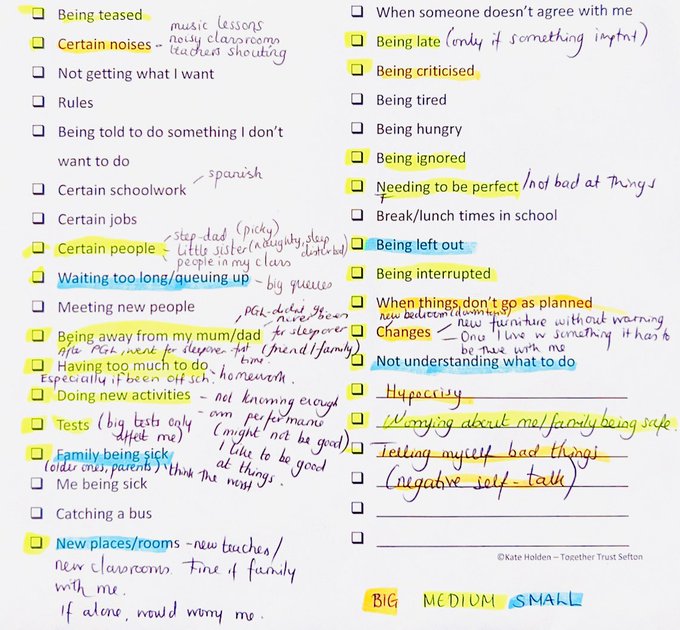(This resource has been developed by Kate Seasman of the Together Trust who gave kind permission to share here. Below is her explanation).
As an adult, what makes you anxious? You can probably name a few things but it would likely take some time to come up with all your triggers and you may not even remember some of them. Often it is difficult for children and young people to think about and verbalise what makes them anxious and if they can’t pinpoint their triggers, the teaching and use of strategies will be less effective. How can you do something about your worries if you don’t know what can make you feel that way?
You can use this prompt activity to help young people identify their triggers. It really helps if you talk around each one. If a child identifies that noise is a trigger, what types of noises, in what environments and can there be times they can tolerate the noise more or less? This kind of exploration will give you a much deeper insight which will enable more personalised coping strategies or changes to the environment or approaches from people supporting them.
Before using this particular activity, I will have spent a few sessions teaching young people about what anxiety is, what happens in their brain and body when we are anxious and the physical and cognitive signs of anxiety. The young person will have already done an activity which examines what anxiety looks and feels like for them in different parts of their body.
To use this activity, I ask the young people to tick their triggers and then we talk around them.
Next, we colour-code the triggers into those that would cause big, medium and small feelings. Some young people will need further explanation of what a big, medium or small anxiety feeling might be like.
After we have done this, we then start to explore strategies.
For a more tactile version, you can put all the statements in the ticklist on small cards or post-it notes and ask the young person to sort them out into piles of yes and no. Following this, take the ‘yes’ ones and sort them into ‘big, medium and small’ triggers. It can be really nice doing it like this as when you talk around the triggers, the young person can shift them around if they want to change their mind.
With younger children and those who like a lot of movement, you could hide the cards around the room so they can move around and look for them before doing the card activity described above.
About Kate
Kate Seasman works for Together Trust, one of the North West’s leading children’s charities. She is an autism advisory teacher and also manages a specialist sleep service which supports families of children and young people who are struggling with sleep. Her team also provide sleep training for professionals who work in health care, social care and education. To find out more about the sleep service, follow this link where you will also find a link to download a brochure of the services offered and downloadable sleep information and advice: Together Trust Sleep Services | Together Trust
You can get in touch with Kate by emailing [email protected] or tweeting @KateSeasman_ASC
Here is an example of a completed version:





